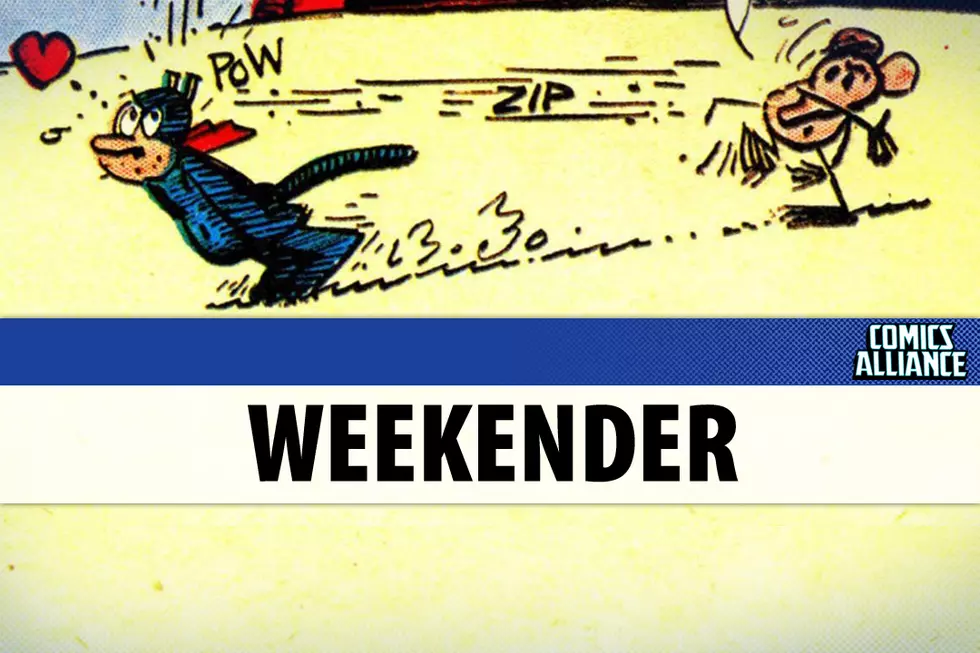![‘Wild Blue Yonder’ Brings Desperate Battle To The Skies [Review]](http://townsquare.media/site/622/files/2013/06/wbytsmmain.jpg?w=980&q=75)
‘Wild Blue Yonder’ Brings Desperate Battle To The Skies [Review]
Wild Blue Yonder isn't the book I expected it to be. That's not a knock on what it is; it's just that I thought from the title and the cover that I was in for a very specific kind of story, something that was slightly more focused on big sweeping airplanes and slightly less apocalyptic, and it turns out that wasn't the case. Maybe it's just me and my love of being right all the time, but usually when that happens, it's a disappointment. When I got through what Mike Raicht, Zach Howard and Austin Harrison are doing with their first issue, however, it was exactly the opposite.
This might not be the book I expected, but it's definitely one that's worth picking up.
Even though it's one of the most criminally underserved markets in the entire comics industryI love stories about air pirates. I think it goes back to when I was a kid and I obsessed over the Rocketeer and the Disney Afternoon's TaleSpin -- which, if you've never seen it, was an adventure cartoon about a cargo plane service in which the cast of The Jungle Book was inexplicably dropped into a simulacrum of the '40s, with Shere Khan as Lex Luthor and the addition of a standard-issue Radical Teen. It may in fact be the weirdest reboot to get get a green light for kids' TV, but as weird as it was, something about it stuck with me.
Ever since, I've always had an interest in those stories, full of narrow escapes, dogfights, last-minute bailouts, the freedom of the sky, all that stuff. That's what made me want to read Wild Blue Yonder in the first place, the retro-style cover of a pilot surrounded by explosions and ominously looming figures, and a dog wearing goggles.
A dog wearing goggles, you guys. I'm not made of stone.
But like I said, this isn't that book. It's close -- there are planes, daring escapes, and at least one dude bailing out with a parachute that's picked up by another plane before he gets to the ground -- but the entire style is different from what I expected. And it's great.
Rather than taking place in a world where the sky is this vast blue battleground full of freedom and islands of danger, Raicht, Howard and Austin's story goes the opposite direction. Wild Blue Yonder's version of the sky is a dismal battleground that everyone involved has been forced into because there just isn't anywhere else left. Despite the title, colorist Nelson Daniel only actually uses the color blue on one page, instead putting the story's airplanes against backgrounds of toxic brown clouds, rusted-metal sunsets and fiery explosions.
Even with all the dismal colors, though, it still looks crisp. That's a difficult trick to pull off, but Daniel does it, and on top of Howard's scratchy line work and zip-a-tone effects, it gives the story a really compelling look to it. There's a desperation to everything that we're seeing right from the start, that only goes away the first time a plane takes off and rises above it all for the span of six panels.
The reason for all this is washed-out color, of course, that it's actually a post-apocalyptic air pirate story, because having only one genre is for squares. That can be a pretty big red flag -- it's definitely a setup that's put me to sleep in other books -- but Yonder deals with it the exact right way. All the "world-building" stuff is neatly tucked away by the end of page two.
It's a compelling idea, but the best thing about it is that there's no big wall of text explaining it that outstays its welcome. There's enough there to get you up to speed on the basic premise, but not so much that your doctor will advise you against operating heavy machinery for six hours after you read it. Here's how it is, here's a little of how we got there, and now we can get down to the business of actually exploring it.
From a storytelling standpoint, the most interesting thing that this setup does is that it ups the danger beneath the story to compliment the stuff in the sky. That's always an element of air combat stuff, but here, it's not just the threat of crashing. They've made landing dangerous, to the point where even bailing out is a last resort. It's such a simple twist to the formula, but I love how much it changes things. It even makes the aerial battles feel more important, because they've established that there's nowhere to run.
And when those battles do happen, it's pretty great.
I mentioned before that Wild Blue Yonder doesn't have those sweeping dogfights that I like to see in stories like this, and that's true. There aren't a lot of Joe Kubert Enemy Ace-style close-ups of enemy planes in the crosshairs or big loops to avoid enemy fire, and that's by design. Yonder's version of a dogfight is tense and cramped. That feeling of being trapped is done really well, and instead of breaking things out into larger battle shots, Howard instead makes the panels smaller and tighter, with the characters looking around desperately for the next attack, or trying to hit pinpoint targets from a distance.
Also, and I cannot oversate the importance of this aspect of the book, there are "jetpack warriors."
That's what really got me about this book. As dark and violent and desperate as it is in tone, it still has fun with what it's doing. And it should! It's a book about air pirates and solar powered airships and an ominous evil figure looming over everyone who's essentially Darth Vader, if Vader preferred stabbing people in the gut to make a point over choking them out with his magic powers. That's the thing that makes this book bearable, even for someone who generally doesn't like titles that are steeped in dusty grimness.
That stuff's in there, and it's a big part of the book, but it's done well. And more than that, it provides the background for characters that are instantly easy to connect with, having adventures where the stakes are clear and important. It's a solid debut, and I'm looking forward to more.
More From ComicsAlliance



![Mairghread Scott Brings Windblade Soaring Back, Just in Time for “Transformers: Combiner Wars” [Interview]](http://townsquare.media/site/622/files/2015/01/windblade-hed.jpg?w=980&q=75)





